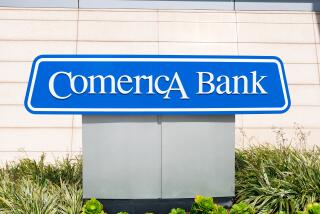Bank Profits Hit 53-Year Low in ’87 : FDIC Chairman Predicts Better Performance This Year
- Share via
WASHINGTON — Banks recorded their least profitable year in 1987 since the Great Depression, but a top federal regulator said Wednesday that he sees better days ahead.
The nation’s federally insured commercial banks earned $3.7 billion last year on assets of $3 trillion, down from $17.5 billion in earnings in 1986, said L. William Seidman, chairman of the Federal Deposit Insurance Corp.
That amounted to a return on assets of only 0.13% last year and was the lowest level since the FDIC, which insures deposits of up to $100,000, was established in 1934.
The year-to-year drop in earnings was due entirely to large banks adding to reserves to cover anticipated losses on loans to Third World countries, Seidman said. Nine of the 10 largest banks and 17 of the 25 largest reported a loss for 1987.
“Absent the extraordinary reserving for (developing country) loans . . . net income would have been roughly equal to 1986’s level,” Seidman said in the FDIC’s bank profile for the fourth quarter of 1987.
Seidman said he believed that there was a good chance banks could avoid further large additions to reserves for bad Third World loans and said, “The outlook for 1988 is cautiously optimistic.”
“Barring any new shocks, loan-loss provisioning should be lower than usual this year, and profitability at money center and regional banks will be much improved,” Seidman said, predicting that bank profits this year could return to about the 1986 level.
He also said office occupancy rates and other signs appear to indicate that the economy of the Southwest, which accounted for more than half of last year’s bank failures, may have hit bottom and may be on the rebound. But he cautioned that much of the region’s health depends on oil prices remaining stable or rising.
Fewer Member Banks
The oil-producing states of Texas, Louisiana and Oklahoma accounted for 95 of last year’s 184 bank failures, the most recorded since 1933. Twenty-eight banks have failed in the first two months of this year, 16 of them in the three oil states.
The number of federally insured commercial banks, which is shrinking because of failures and mergers, dwindled from a peak of about 14,500 in 1985 to about 13,700 last year, the lowest number since 1971.
The results for all of 1987 masked a more positive fourth quarter. Despite loan-loss provisions of $7.7 billion for the quarter, banks posted a $3.2-billion profit, 25% higher than the last quarter of 1986.
Seidman said banks were especially strengthened in the fourth quarter by a flood of new deposits as investors after the Oct. 19 stock market crash pulled their money out of stocks and put it into insured bank accounts.
The crash also triggered a surge in loan demand from stock brokerages and other financial service firms, the FDIC chairman said. And, because the Federal Reserve pumped money into the economy in response to the crash, banks are enjoying lower interest rates.
Another encouraging sign, Seidman said, was the drop to 1,559 from 1,609 during the last half of 1987 in the number of banks on the FDIC’s problem list.
In addition, the number of banks losing money fell for the first time since 1980. The FDIC estimated that 2,366 banks were unprofitable last year, down from 2,784 in 1986 and 2,453 in 1985.
In a report earlier this week, the FDIC said its insurance fund held steady in 1987 despite the heavy load of bank failures. The fund finished the year at $18.3 billion, up modestly from $18.25 billion at the end of 1986.
The slight gain was posted despite a provision for the second-largest bank rescue ever by the FDIC. Shareholders of First City Bancorporation of Houston are scheduled to vote Friday on a restructuring package that would involve nearly $1 billion in government assistance.
More to Read
Sign up for Essential California
The most important California stories and recommendations in your inbox every morning.
You may occasionally receive promotional content from the Los Angeles Times.













